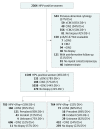Five-Year Risk of Cervical Precancer Following p16/Ki-67 Dual-Stain Triage of HPV-Positive Women
- PMID: 30325982
- PMCID: PMC6439556
- DOI: 10.1001/jamaoncol.2018.4270
Five-Year Risk of Cervical Precancer Following p16/Ki-67 Dual-Stain Triage of HPV-Positive Women
Abstract
Importance: As cervical cancer screening transitions to primary human papillomavirus (HPV) testing, effective triage and management of HPV-positive women is critical to avoid unnecessary colposcopy referral and associated harms while maintaining high sensitivity for cervical precancer. Triage with p16/Ki-67 dual-stain (DS) testing has shown high sensitivity and specificity for detection of cervical precancers; however, longitudinal studies are needed to determine the long-term risk of precancer following a negative DS result.
Objective: To evaluate the longitudinal performance of p16/Ki-67 DS triage for detection of cervical precancer in HPV-positive women over 5 years of follow-up in the context of clinical management thresholds.
Design, setting, and participants: Prospective cohort study of HPV-positive women 30 years or older undergoing routine cervical cancer screening in 2012 with HPV and Papanicolaou (hereinafter "cytology") co-testing within the Kaiser Permanente Northern California health care system. Follow-up of medical records was conducted through 2017.
Exposures: All p16/Ki-67 DS testing was performed on residual SurePath material, and slides were evaluated for p16/Ki-67 positivity.
Main outcomes and measures: Histological end points were ascertained from the clinical database through 2017. We estimated 5-year cumulative risks of cervical intraepithelial neoplasia grades of 2 or worse (≥CIN2) or grades 3 or worse (≥CIN3) by baseline DS and cytology at yearly intervals using Logistic Weibull models. Risks were compared with clinical management thresholds for colposcopy referral and a 1-year return interval.
Results: Among the 1549 HPV-positive women in this study, the mean age at enrollment was 42.2 years, and the median follow-up time was 3.7 years (range, 0.2-5.4 years). Positive DS results were associated with significantly higher cumulative 5-year risks of ≥CIN2 compared with abnormal cytology (31.0%; 95% CI, 27.2%-35.3% vs 25.0%; 95% CI, 21.7%-28.7%; P = .03). Women with DS-negative findings had significantly lower 5-year risks of ≥CIN2 compared with women with normal cytology (8.5%; 95% CI, 6.5%-11.1% vs 12.3%; 95% CI, 9.8%-15.4%; P = .04). In DS-negative women, the risks of both ≥CIN2 and ≥CIN3 remained below the colposcopy referral threshold for all 5 years, crossing the 1-year return threshold at 3 years.
Conclusions and relevance: Triage with p16/Ki-67 DS provides better long-term risk stratification than cytology over 5 years. The low risk of cervical precancer in p16/Ki-67 DS-negative women permits safe extension of follow-up intervals for 3 years.
Conflict of interest statement
Figures



References
-
- Saslow D, Solomon D, Lawson HW, et al. . American Cancer Society, American Society for Colposcopy and Cervical Pathology, and American Society for Clinical Pathology screening guidelines for the prevention and early detection of cervical cancer. J Low Genit Tract Dis. 2012;16(3):175-204. doi:10.1097/LGT.0b013e31824ca9d5 - DOI - PMC - PubMed
-
- Benevolo M, Allia E, Gustinucci D, et al. ; New Technologies for Cervical Cancer Screening 2 (NTCC2) Working Group . Interobserver reproducibility of cytologic p16INK4a /Ki-67 dual immunostaining in human papillomavirus-positive women. Cancer Cytopathol. 2017;125(3):212-220. doi:10.1002/cncy.21800 - DOI - PubMed
Publication types
MeSH terms
Substances
LinkOut - more resources
Full Text Sources
Other Literature Sources
Medical
Research Materials
Miscellaneous

